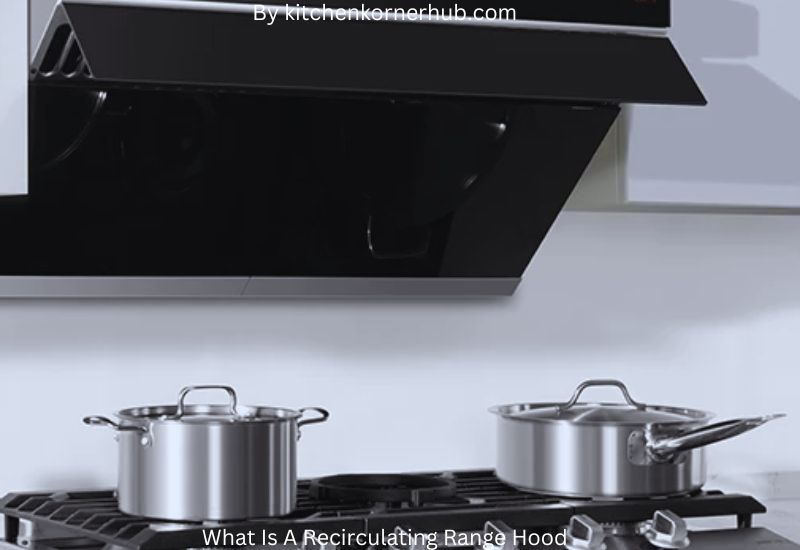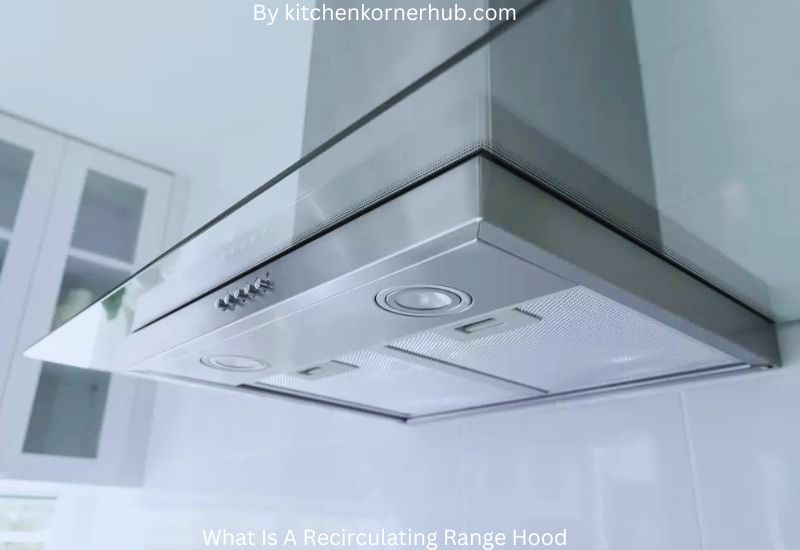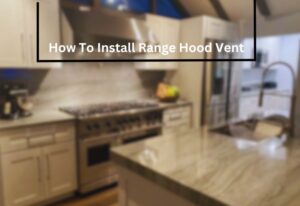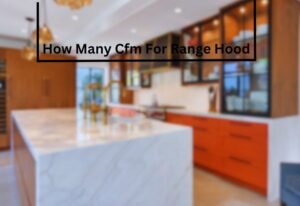A recirculating range hood might sound a bit technical, but it’s actually a nifty kitchen device that helps keep your cooking area fresh and clean. Think of it as a superhero for your kitchen, fighting against the unwanted odors and steam that cooking can bring.
What Is A Recirculating Range Hood? A recirculating range hood is a kitchen appliance designed to improve indoor air quality by capturing and filtering cooking odors, smoke, and grease particles. Unlike traditional vented hoods that expel air outside, recirculating hoods purify air through filters and then release it back into the kitchen.
When you cook, especially if it involves frying or using strong spices, you’re likely to notice lingering smells and even a bit of smokiness in the air. That’s where a recirculating range hood steps in. It’s like a powerful vacuum for air, sucking up those smells and steam, and then cleaning and releasing the air back into your kitchen. Unlike traditional range hoods that send the air outside, recirculating hoods use filters to remove particles and odors before sending the air back into your kitchen.
So, in simple terms, a recirculating range hood is your kitchen’s ally in the battle against cooking odors, helping you enjoy a fresh and pleasant cooking environment without the hassle of venting air outside.
Understanding Recirculating Range Hoods

When it comes to maintaining a clean and odor-free kitchen, a vital appliance often goes unnoticed: the recirculating range hood.
This unassuming device plays a crucial role in improving indoor air quality and ensuring a pleasant cooking experience. Let’s delve into the details of recirculating range hoods, how they work, and why they are an essential addition to your kitchen.
Introduction to Recirculating Range Hoods
A recirculating range hood is a kitchen appliance designed to remove smoke, grease, and odors produced during cooking.
Unlike traditional ducted range hoods that vent air outside, recirculating range hoods utilize a filtration system to clean the air before releasing it back into the kitchen. This makes them suitable for kitchens without external ventilation options.
Working Mechanism
Recirculating range hoods operate through a multi-stage process. First, the air laden with cooking byproducts is drawn into the hood.
Then, it passes through a series of filters, including grease filters and charcoal or activated carbon filters. Grease filters capture larger particles, while carbon filters effectively trap odors and smaller particles. Once the air is purified, it is recirculated back into the kitchen environment, significantly reducing the amount of smoke, grease, and odors.
Benefits of Recirculating Range Hoods
One of the main advantages of recirculating range hoods is their versatility. They can be installed in virtually any kitchen since they do not require external ducting.
This makes them a great option for apartments, condominiums, and homes without existing venting infrastructure. Additionally, recirculating hoods are generally easier and less expensive to install compared to ducted hoods.
Considerations for Effective Use
While recirculating range hoods offer numerous benefits, their efficiency can be influenced by several factors. Regular maintenance is crucial to ensure optimal performance. Grease filters should be cleaned or replaced as needed, and carbon filters must be changed periodically to maintain their effectiveness.
It’s also important to be aware that while recirculating hoods can significantly reduce odors and smoke, they may not eliminate them entirely, especially during heavy cooking sessions.
Enhancing Performance
To enhance the effectiveness of a recirculating range hood, consider a few additional measures. Using cookware lids when cooking can help reduce the release of steam and smoke.
Cooking at lower temperatures and avoiding excessive frying can also minimize the amount of airborne particles. Moreover, proper positioning of the range hood, typically around 24 to 30 inches above the cooking surface, ensures optimal capture of pollutants.
How Recirculating Range Hoods Differ from Vented Hoods

When it comes to kitchen ventilation, range hoods play a crucial role in maintaining air quality and eliminating cooking odors. Two popular options for range hoods are recirculating range hoods and vented hoods
. Each type comes with its own set of advantages and limitations, catering to different kitchen setups and homeowner preferences.
Air Circulation Mechanism: Recirculating Range Hoods
Recirculating range hoods, also known as ductless hoods, employ a distinct mechanism to filter and clean the air. Instead of expelling the cooking fumes and particles outside, these hoods pull the air through a series of filters designed to trap grease, smoke, and odors.
The purified air is then released back into the kitchen space. This approach eliminates the need for an external duct system, making it a suitable choice for kitchens where installing ducts is impractical or costly.
Ventilation Efficiency: Vented Hoods
Vented hoods, on the other hand, are directly connected to an external duct system that channels the cooking byproducts outdoors. This mechanism is highly effective in quickly removing smoke, steam, and odors from the kitchen, ensuring optimal air quality.
Vented hoods are particularly beneficial for kitchens with heavy cooking demands or where strong odors are a concern. However, the installation process can be more complex and expensive due to the need for ductwork.
Installation Flexibility: Recirculating Range Hoods
One of the primary advantages of recirculating range hoods is their installation flexibility. Since they don’t require ductwork, these hoods can be easily mounted in various locations within the kitchen, giving homeowners greater freedom in designing their kitchen layout.
This flexibility can be especially advantageous for apartments, rental properties, or kitchens with limited space for duct installations.
Performance Considerations: Vented Hoods
While recirculating range hoods offer convenience in installation, vented hoods excel in terms of performance. The direct expulsion of cooking pollutants outside significantly reduces indoor air pollution, creating a healthier and more comfortable kitchen environment.
Vented hoods are highly recommended for those who frequently cook foods with strong odors or high levels of smoke.
Maintenance and Filter Replacement: Recirculating vs. Vented Hoods
Maintenance requirements differ between the two types of hoods. Recirculating range hoods necessitate periodic filter replacement to ensure their efficiency in capturing airborne particles.
Vented hoods, although more effective in removing pollutants, require less frequent filter replacements as their primary function is expelling air. However, homeowners with vented hoods should be mindful of keeping the ductwork clean and free from blockages.
Installation and Maintenance of Recirculating Range Hoods

Recirculating range hoods have become an indispensable appliance in modern kitchens, effectively removing cooking odors, grease, and smoke from the air.
The proper installation and regular maintenance of these range hoods are crucial to ensure their optimal performance and longevity. This article delves into the essential aspects of installing and maintaining recirculating range hoods.
Installation:
When installing a recirculating range hood, several factors need to be considered. Firstly, the location of the range hood is vital. It should be placed directly above the cooking surface to effectively capture airborne contaminants.
Ensuring that there is enough space between the range hood and the cooking surface will prevent obstructions and maximize its efficiency. Proper ventilation is also key. While recirculating range hoods do not require an external vent, they should still be positioned near an exterior wall for easy installation of ductwork if needed in the future. The hood should be securely mounted, adhering to the manufacturer’s instructions, to prevent vibrations and reduce noise during operation.
Ventilation System:
Recirculating range hoods utilize a filtration system to trap airborne particles and odors. The filters, typically made of charcoal and/or grease-trapping materials, need regular replacement or cleaning.
This step is essential to maintain the efficiency of the range hood. Manufacturers usually recommend a specific schedule for filter replacement, which can vary depending on the frequency of cooking and the type of food prepared. Neglecting filter maintenance can lead to decreased performance and the recirculation of impurities back into the kitchen air.
Cleaning and Maintenance:
Routine cleaning of the exterior and interior components of the recirculating range hood is vital for its longevity. Grease and grime can accumulate on the surfaces, diminishing both its aesthetic appeal and functionality. Regularly wiping down the hood’s exterior with a mild detergent and warm water will prevent stubborn stains from forming. The interior surfaces and filters should also be cleaned according to the manufacturer’s guidelines. Failure to maintain cleanliness can lead to reduced air circulation, increased noise levels, and potential fire hazards due to accumulated grease.
Filter Replacement:
As mentioned earlier, the filters play a crucial role in recirculating range hoods. Charcoal filters, responsible for trapping odors, become less effective over time. It’s essential to replace these filters as recommended by the manufacturer.
Grease filters, responsible for capturing grease particles, should also be cleaned or replaced regularly. A clogged filter can obstruct airflow, leading to decreased performance and potential overheating. Following the recommended filter replacement schedule will ensure the range hood operates efficiently.
Professional Maintenance:
While regular user maintenance is essential, periodic professional maintenance is also recommended. Engaging a qualified technician to inspect and service the range hood can identify issues that might go unnoticed by the user.
They can clean the internal components thoroughly, ensure proper ventilation, and address any mechanical or electrical problems. Professional maintenance not only prolongs the lifespan of the range hood but also guarantees its safe operation.
Environmental Impact and Energy Efficiency of Recirculating Range Hoods

Recirculating range hoods, a prominent fixture in modern kitchens, have garnered increasing attention due to their potential environmental impact and energy efficiency. These appliances are designed to remove pollutants, smoke, and odors generated during cooking, enhancing indoor air quality and creating a comfortable cooking environment
. However, their environmental implications and energy consumption deserve careful consideration.
Reducing Airborne Contaminants:
One of the primary benefits of recirculating range hoods is their ability to minimize the release of airborne contaminants into the atmosphere. Instead of venting pollutants outside, these hoods utilize filters to capture grease, particulate matter, and odorous compounds.
By doing so, they prevent the dispersion of harmful substances, contributing to a healthier indoor and outdoor environment.
Energy Efficiency and Resource Conservation:
Recirculating range hoods tend to be more energy-efficient compared to their ducted counterparts. Ducted hoods expel air outdoors, often requiring more power to overcome the resistance of the ductwork.
Recirculating hoods, on the other hand, use fans primarily for drawing air through filters, which can result in lower energy consumption. This efficiency can translate into reduced energy bills and a smaller carbon footprint.
Filter Maintenance and Waste Generation:
While recirculating range hoods offer environmental advantages, they do generate some waste in the form of used filters. Regular maintenance and replacement of filters are essential to maintain the hood’s efficiency.
To mitigate the environmental impact of discarded filters, manufacturers and consumers should explore options for recycling or upcycling these materials, minimizing their contribution to landfill waste.
Choosing Sustainable Materials:
The environmental impact of recirculating range hoods also depends on the materials used in their construction.
Opting for hoods made from sustainable and recyclable materials, such as stainless steel or eco-friendly plastics, can reduce the overall ecological footprint of the product. Manufacturers can further enhance sustainability by incorporating design features that extend the lifespan of the hood, reducing the need for premature replacements.
Balancing Performance and Efficiency:
Balancing the performance of recirculating range hoods with energy efficiency is crucial. Some hoods might sacrifice filtration effectiveness for lower energy consumption, leading to compromised indoor air quality.
Striking the right balance requires thorough research and consideration of factors such as the type of cooking being done and the hood’s filtration capacity. Consumers can benefit from consulting energy efficiency ratings and product reviews to make informed choices.
Conclusion
In conclusion, a recirculating range hood serves as an efficient solution for kitchen ventilation in spaces where ducted systems are not feasible. By employing a combination of filters to trap grease and odors, these hoods purify the air before recirculating it back into the room. While not as effective as ducted models in removing heat and moisture, they still offer a practical option for improving indoor air quality.
Their ease of installation and versatility make them suitable for apartments and homes lacking ductwork. Ultimately, a recirculating range hood presents a valuable choice for maintaining a cleaner and more pleasant kitchen environment.
Frequently Asked Question(What Is A Recirculating Range Hood)
Are recirculating range hoods any good?
Recirculating range hoods can be a suitable option for kitchens where traditional venting isn’t feasible. They work by filtering the air through a series of charcoal or other specialized filters to remove odors, smoke, and grease particles.
While they may not be as efficient as ducted range hoods in terms of completely removing pollutants from the kitchen, they can still offer significant benefits in terms of air quality improvement. However, their effectiveness can depend on the quality of the filters used and the specific cooking habits in the kitchen.
Is it better to vent or recirculating a range hood?
The choice between venting and using a recirculating range hood depends on your kitchen’s setup and your priorities. Venting range hoods, also known as ducted range hoods, are generally more effective at removing pollutants directly outside the home, ensuring better air quality.
On the other hand, recirculating range hoods are a good option if you lack the infrastructure for ducting, as they clean and recirculate the air indoors. While they might not provide the same level of air purification as vented hoods, they can still significantly improve the kitchen’s environment by capturing and filtering airborne particles.
Do recirculating range hoods need to be vented?
Recirculating range hoods do not require external venting like ducted range hoods do. Instead of venting the air outside, recirculating range hoods use filters to capture and clean the air, removing contaminants such as smoke, odors, and grease particles.
This filtered air is then released back into the kitchen. This makes recirculating range hoods a viable option for kitchens without access to outdoor ventilation systems or in situations where modifying the infrastructure for ducting is not feasible.
What is the difference between ducted and recirculating range hoods?
The primary difference between ducted and recirculating range hoods lies in how they handle the airflow and pollutants generated during cooking. Ducted range hoods vent the air outside through a system of ducts and vents, effectively expelling the contaminants from the kitchen environment.
Recirculating range hoods, on the other hand, utilize filters to capture and purify the air before releasing it back into the kitchen. While ducted hoods are generally more effective at removing pollutants directly from the home, recirculating hoods can still provide improved air quality by filtering out smoke, odors, and grease particles. The choice between the two types depends on factors such as kitchen layout, available infrastructure, and the desired level of air purification.
What is the purpose of recirculating?
Recirculating serves an essential purpose in the context of ventilation and air quality control. When we talk about recirculating, we refer to a process commonly used in kitchen range hoods and air purifiers. The purpose of recirculating is to clean and filter the air within a specific space, typically a kitchen or a room, by capturing and removing airborne particles, odors, and pollutants.
In the case of a range hood, recirculating means that instead of expelling the air outside, it circulates the air through filters before reintroducing it into the room. This process helps remove cooking odors and grease particles, ensuring better indoor air quality. For air purifiers, recirculating involves constantly cycling the room air through filters to remove allergens, dust, and pollutants, ultimately improving the overall air quality within a confined area.
How do I know if my range hood is ducted or recirculating?
To determine whether your range hood is ducted or recirculating, you can follow a few simple steps. First, inspect the range hood’s installation. If you notice a duct or pipe leading from the hood to the outside of your home, it’s likely a ducted range hood. This design expels cooking byproducts and odors outdoors, which is often considered more effective. On the other hand, if you can’t find any external duct or if the hood has an additional filter panel or compartment inside, it’s likely a recirculating range hood. Recirculating range hoods are equipped with filters to capture grease and odors before returning the air back into the kitchen.
Another clue is to check for a control panel or switch that allows you to select different fan speeds or modes, including a recirculation mode. Review the product manual or specifications that came with your range hood, as they often provide information about its ventilation type. If you’re still uncertain, consulting a professional installer or contacting the manufacturer’s customer support can provide you with a definitive answer regarding your range hood’s ventilation system.




